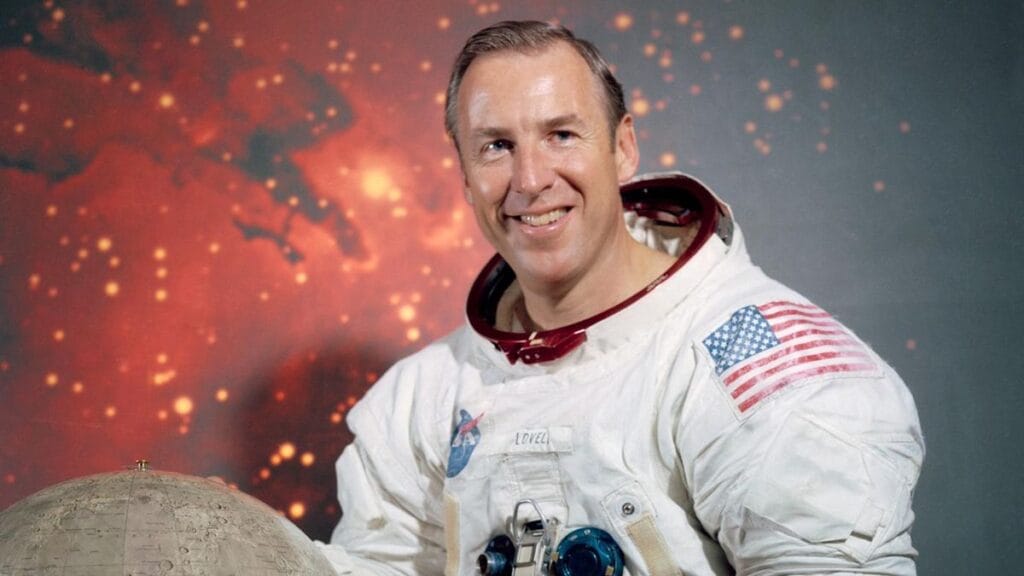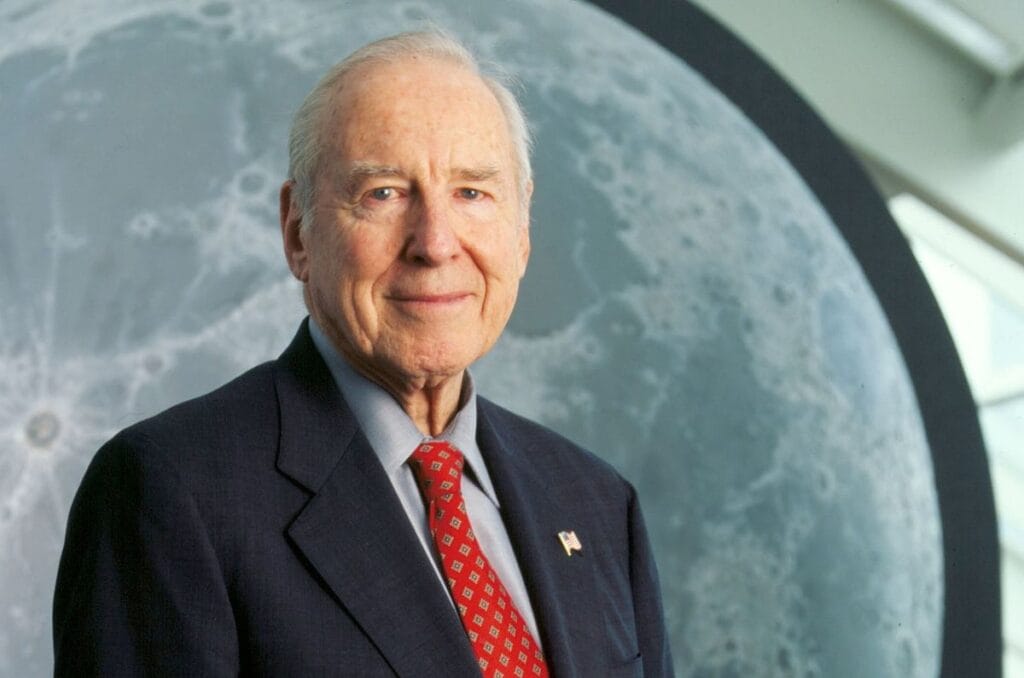Jim Lovell the legendary Apollo 13 commander who turned NASA’s near-tragic mission into a story of heroism, has died at age 97. Explore his life, space missions, and legacy.

A National Hero’s Final Goodbye
On August 7, 2025, the United States and the world lost one of its most celebrated space pioneers. James A. “Jim” Lovell Jr., best known as the commander of the near-disastrous Apollo 13 mission, passed away peacefully at his home in Lake Forest, Illinois. He was 97 years old.
NASA confirmed his passing in an emotional statement, calling Lovell “a true American hero whose calm leadership in the face of crisis inspired the world and saved the lives of his crew.” His death marks the end of an era for the generation that saw space travel transform from science fiction into reality.
Early Life: A Boy Who Dreamed of the Stars
Jim Lovell was born on March 25, 1928, in Cleveland, Ohio, during the Great Depression. His father died when he was young, and Lovell’s mother raised him largely on her own. From an early age, Lovell was fascinated by rockets and aviation.
In high school, he built model rockets and read everything he could about the pioneers of flight. This fascination led him to pursue a career in aviation — a dream that would eventually place him among the first humans to venture to the Moon.
He attended the United States Naval Academy, graduating in 1952. Soon after, he became a naval aviator and later a test pilot, flying cutting-edge jets at speeds and altitudes few had experienced.
NASA Calls: The Second Astronaut Group
In 1962, Jim Lovell was selected as part of NASA’s Astronaut Group 2, often referred to as “The New Nine.” This elite group included future legends like Neil Armstrong and Pete Conrad. Lovell’s engineering skills, calm demeanor, and flight experience made him a natural choice for missions that required precision and leadership.
Four Historic Space Missions
Over his NASA career, Jim Lovell flew four space missions, spending more than 29 days in space — an extraordinary achievement in the 1960s and early 1970s.
1. Gemini 7 (1965)
Jim Lovell first spaceflight paired him with astronaut Frank Borman for a record-breaking 14-day mission. The cramped capsule was no bigger than the front seat of a car. Gemini 7 achieved the first space rendezvous in history with Gemini 6A, paving the way for docking maneuvers essential for lunar missions.
2. Gemini 12 (1966)
Commanding Gemini 12 with Buzz Aldrin, Jim Lovell oversaw critical extravehicular activity (EVA) experiments, refining spacewalk techniques and proving astronauts could work effectively outside their spacecraft.

3. Apollo 8 (1968)
Perhaps one of the most profound moments in human history, Apollo 8 was the first manned mission to orbit the Moon. Lovell, Borman, and William Anders captured the now-iconic “Earthrise” photograph, changing humanity’s perspective of our place in the universe. Lovell’s calm navigation helped ensure the mission’s success.
4. Apollo 13 (1970)
The mission that defined Lovell’s legacy — and NASA’s resilience.
Apollo 13: NASA’s “Successful Failure”
Apollo 13 launched on April 11, 1970, with Jim Lovell as commander, Jack Swigert as command module pilot, and Fred Haise as lunar module pilot. The mission’s goal was to land on the Moon’s Fra Mauro formation.
Two days into the flight, disaster struck. An oxygen tank exploded, crippling the spacecraft. Lovell’s now-famous words, “Houston, we’ve had a problem here,” signaled the beginning of a tense rescue effort that would last nearly four days.
With limited power, heat, and oxygen, the crew and NASA engineers on the ground devised an emergency plan. They used the lunar module as a lifeboat, looping around the Moon to gain the speed needed to return to Earth.
Lovell’s leadership under pressure, combined with the ingenuity of NASA’s ground team, brought Apollo 13 safely home on April 17, 1970. The mission was dubbed a “successful failure” — failing to land on the Moon but succeeding in saving the crew’s lives.
Recognition and Awards
For his role in Apollo 13, Jim Lovell received the Presidential Medal of Freedom, one of the highest civilian honors in the United States. He also earned the Congressional Space Medal of Honor in 1995 and numerous NASA Distinguished Service Medals.
His story inspired books, documentaries, and the 1995 Academy Award-winning film Apollo 13, starring Tom Hanks as Lovell. The movie introduced a new generation to the courage and teamwork that defined the mission.
Life After NASA
Jim Lovell retired from the Navy and NASA in 1973, transitioning into a successful business career. He held executive positions in telecommunications and energy companies. Later, he pursued a more personal project — opening Lovell’s of Lake Forest, a restaurant filled with Apollo memorabilia and artifacts from his career. The restaurant became a local landmark until it closed in 2015.

Public Speaking and Writing
Lovell co-authored the 1994 book Lost Moon: The Perilous Voyage of Apollo 13 with journalist Jeffrey Kluger, which became the basis for the film Apollo 13. He also became a sought-after public speaker, sharing lessons in leadership, teamwork, and crisis management with audiences worldwide.
Tributes from Colleagues and Fans
NASA’s Acting Administrator called Lovell “a man whose courage helped define America’s space program.” Tom Hanks, reflecting on portraying Lovell, said:
“Jim taught me that real leadership is not about glory — it’s about taking care of your crew.”
Lovell’s family released a heartfelt statement:
“We are enormously proud of his amazing life and career accomplishments. But to us, he was Dad, Granddad, and the leader of our family. We will miss his unshakeable optimism, his humor, and the way he made each of us feel we could do the impossible.”
Legacy in Space History
Jim Lovell’s name will always be linked to the courage and ingenuity of the Apollo era. His ability to remain calm under extreme pressure has made him a case study in crisis leadership. His missions contributed to the engineering, navigation, and survival techniques still used in space exploration today.
As one of only three people to travel to the Moon twice, Lovell is part of an elite chapter in human history. Although he never walked on the lunar surface, his contribution to space exploration is immeasurable.
Quick Facts About Jim Lovell
- Full Name: James Arthur Lovell Jr.
- Born: March 25, 1928 — Cleveland, Ohio
- Died: August 7, 2025 — Lake Forest, Illinois
- Space Missions: Gemini 7, Gemini 12, Apollo 8, Apollo 13
- Total Time in Space: 29 days, 19 hours, 39 minutes
- Notable Honors: Presidential Medal of Freedom, Congressional Space Medal of Honor
Final Thoughts
Jim Lovell’s passing is a reminder of the extraordinary bravery and determination that defined the Apollo program. His life’s story is not just about going to space — it’s about what humans can achieve when faced with the impossible.
From a boy with model rockets in Ohio to an astronaut guiding a crippled spacecraft safely back to Earth, Lovell embodied the spirit of exploration, leadership, and hope.
As the world looks to the Moon and Mars once again, the lessons of Jim Lovell’s life remain as relevant as ever: stay calm, think clearly, and never stop reaching for the stars.
Tags: Jim Lovell, Apollo 13, NASA Astronaut, Space History, Moon Missions, Space Exploration, Tom Hanks Apollo 13, American Heroes, Gemini Program, Apollo Program
Hashtags: #JimLovell #Apollo13 #NASA #MoonMission #SpaceHistory #Astronauts #AmericanHeroes













